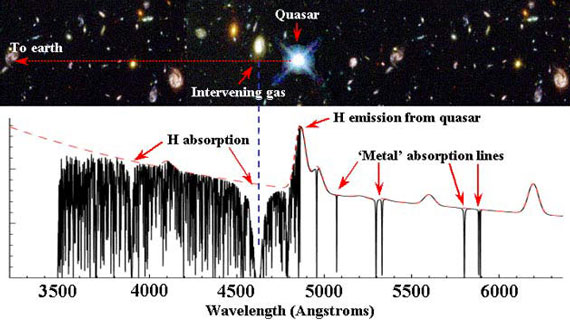| Jan 08, 2014 |
Quasars illuminate swiftly swirling clouds around galaxies
|
|
(Nanowerk News) A new study of light from quasars has provided astronomers with illuminating insights into the swirling clouds of gas that form stars and galaxies, proving that the clouds can shift and change much more quickly than previously thought.
|
|
Led by University of Illinois at Urbana-Champaign astronomy professor Robert J. Brunner and former graduate student Troy Hacker (now with the U.S. Air Force), the astronomers published their findings in the Monthly Notices of the Royal Astronomical Society ("Narrow absorption line variability in repeat quasar observations from the Sloan Digital Sky Survey ").
|
 |
| Invisible gas clouds in galaxies absorb light from background quasars based on the clouds' physical properties. By searching for changes in absorption from repeat observations of the same quasar, University of Illinois astronomers found the first evidence that small-scale gas clouds are likely to exist. (Graphic by John Webb)
|
|
The team used data from the Sloan Digital Sky Survey, a major eight-year cooperative project to image and map galaxies and quasars. A quasar is a supermassive black hole that emits a tremendous amount of energy, like a shining cosmological beacon.
|
|
“Quasars, while very interesting, are merely tools in this study to help us actually find and study what we’re really interested in, which is the invisible gas that surrounds galaxies,” Brunner said. “That gas gets turned into stars, and stars expel gas back out of the galaxy. One of the things we have a hard time understanding is, how is that gas involved in the formation and evolution of a galaxy? So we use quasars as big searchlights.”
|
|
The research team looked at data collected from quasar light that traveled through the gas clouds in galaxies between Earth and the quasars. Like meteorologists who can look at sunlight filtering through clouds to learn about the chemistry and dynamics of the clouds, astronomers can learn a lot about the galaxies that the quasar light travels through by measuring how that light is absorbed.
|
|
The novel aspect of Brunner and Hacker’s work is that it looks at the quasar light not once, but at two different times. Astronomers have long assumed that any changes in large structures such as nebulae or galaxies would take eons and would not be observable during a human lifetime. But in the span of only five years, Brunner and Hacker saw measurable shifts in a small but substantial number of the giant gas clouds mapped by the Sloan Survey.
|
|
“The new aspect of this work is the gas is very distant from the quasar,” Hacker said. “It has no physical interaction with the quasar itself. Something within a galaxy, unassociated with the quasar, is causing the observed change.”
|
|
As a possible explanation, the researchers posit that the gas clouds are much smaller than theories point to.
|
|
“We’re seeing structures on the order of 10, maybe a hundred, astronomical units, and these are orders of magnitude smaller than what other theories are showing,” Hacker said. One astronomical unit is the distance between the sun and Earth. “It brings up a lot more questions. Small structures in other galaxies may be more prevalent than we thought originally. How did they get there? What does this mean for how galaxies form and evolve over time?”
|
|
The questions raised by these findings have implications for how the gas around galaxies is modeled. It is usually modeled as a huge spherical cloud surrounding the galaxy. Because of that size, variability within the cloud would only happen over millions of years. The quick-shifting clouds that the new study found, however, would have to be much smaller or different in composition than previously thought.
|
|
“That means it can’t be a spherical ball of gas; it’s more like the clouds in our atmosphere,” Brunner said. “The gas around other galaxies has different types of structures and shapes. The data are telling us that the dynamics are more complex than previously thought, and you can use that to get a limit on the size and motions of these clouds. Now we can start thinking about tying all these things together – what is the chemistry in these clouds, and how are they tied to the stars in these galaxies?”
|
|
With the Sloan telescope still recording spectroscopic observations, Brunner and Hacker now can provide a target list of particular quasars to re-evaluate to look for this highly variable phenomenon.
|
|
“Now we have the evidence to run a more targeted campaign,” Hacker said. “We can start looking at certain areas where this has been seen. Now that we’ve established this phenomenon, there are so many ways it could go. If we looked at it not just twice, but four, five, six times, we would learn more about these clouds that are moving around and better understand just what is changing.”
|
|
“It’s not just all quiet and calm and peaceful out there,” Brunner said. “There are dynamic, explosive, exciting things happening.
|

